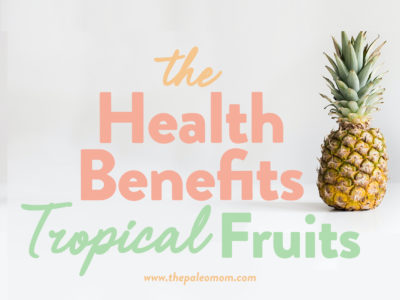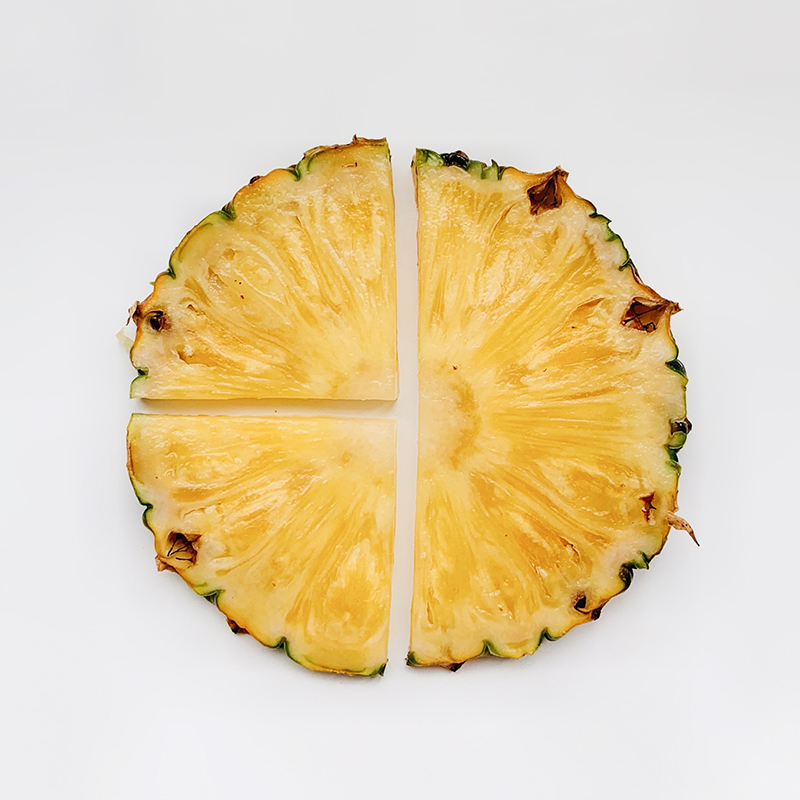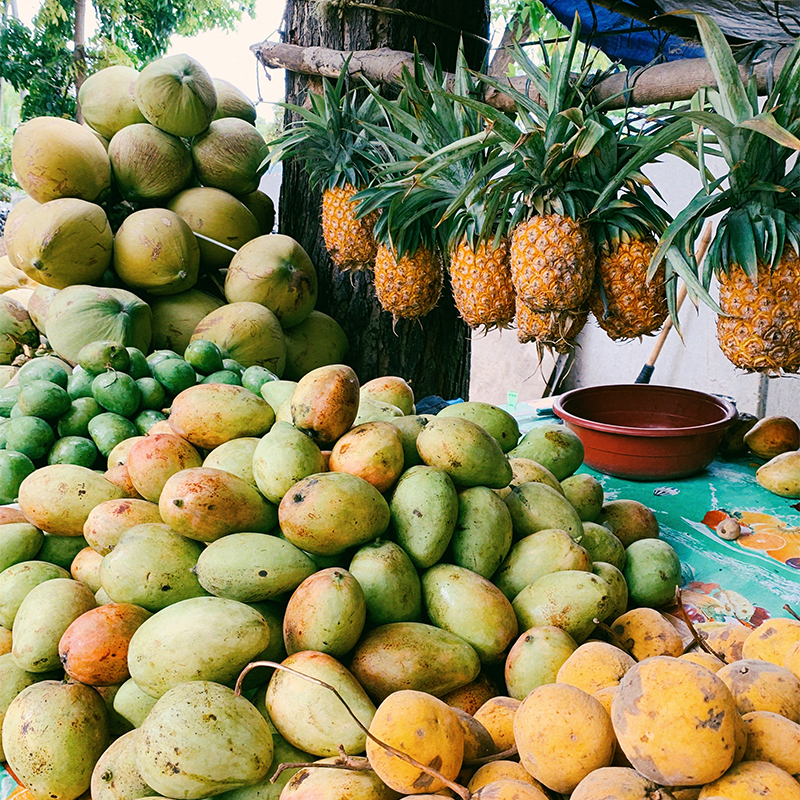ALL fruit have distinct health benefits (see Why Fruit is a Good Source of Carbohydrates, The Health Benefits of Apples, The Health Benefits of Melons, The Health Benefits of Bananas and Plantains, The Health Benefits of Berries and The Health Benefits of Citrus Fruits), and tropical and subtropical fruits are no exception. And yet, in health-conscious communities, fruit has recently earned a bad rap for being “nature’s candy” or a “fructose bomb” or a “bad carb”. Tropical fruit has been especially vilified for its higher sugar content.
Let’s bust these myths and redeem tropical fruit with a dive into the science behind this delicious fruit family’s many health benefits!
What Are Tropical Fruits?
Some of the tastiest fruits around are those that grow in the in the hot, humid regions near the earth’s equator (tropical fruits) or in the subtropical regions adjacent to them (subtropical fruits). The plants bearing these fruits can be woody (like mangoes), herbaceous (like bananas), or vining (like passionfruit), and typically can’t grow at temperatures below 50°F (10°C). Most of us are familiar with the most common tropical fruits:
- Pineapple, which has fibrous yellow flesh with an intense sweet, acidic, tart flavor.
- Mango, which has sweet, tangy yellow or orange flesh and a flat inner seed.
- Papaya, which has creamy, buttery pink or orange flesh with a delicate sweet taste.
- Bananas and plantains, which are starchy and sweet when ripe. (see The Health Benefits of Bananas and Plantains)
However, there are plenty of other tropical and subtropical fruits that we might find seasonally at a local grocery or ethnic foods store. For example:
- Longan, which is small and round with hard outer skin, a single pit, and sweet, musky, fragrant, jelly-like white flesh.
- Lychee, which is similar to longan and has reddish skin and a sweet, tart, aromatic taste reminiscent of grape and rose.
- Rambutan, which is similar to longan and lychee but whose red outer skin is covered in soft prickly spikes.
- Loquat, which are small yellow or orange fruits with succulent, slightly acidic, tangy flesh.
- Guava, which has fragrant flesh that has a crunchy, grainy texture and tastes like a cross between a pear and a strawberry.
- Durian, which is a large fruit with a spikey hard shell (its name derives from the Malay duri, meaning thorns) encasing pods of creamy, custardy flesh that smell like onion (in fact, durian smells so strongly that it’s often banned from hotels and public transportation in Southeast Asia where it grows!). Durian is one of the few fruits with both a high fat and high sugar content!
- Jackfruit, which is the largest fruit in the world (weighing up to 120 pounds!), with waxy, slightly crunchy yellow flesh in the form of pods. It can be eaten ripe (when it’s sweet and tastes similar to a combination of banana, pineapple, and mango) or unripe (when it’s savory and meaty).
- Carambola (star fruit), which is yellow and elongate, forming the shape of a five-pointed star when cut; its flesh is watery and crunchy with a floral, sharp, citrusy taste.
- Mangosteen, which has a deep purple rind encapsulating sweet, juicy, tangy white flesh with a taste similar to peach, strawberry, and pineapple.
- Dragon fruit, which gets its name from its vibrant red skin and green scaly spikes, and has white mild, sweet flesh filled with small black seeds; it grows on a type of cactus whose flowers open only at night.
- Cherimoya (custard apple), which is cone-shaped with green scaly skin and custardy, tangy, sweet flesh.
- Soursop, which has green prickly skin with creamy flesh similar in taste to pineapple or strawberry.
- Canistel (egg fruit), which is marigold colored with dry, sweet flesh resembling hard-boiled egg yolk in texture, with a flavor similar to sweet potato or pumpkin pie.
- Passion fruit, which is round with hard skin and fruity, tart pulp containing numerous edible seeds.
Many of these fruits have long histories in the human diet. For instance, mangos (which are in the same family as cashews!) have been cultivated for many thousands of years, and were brought to Southeast Asia sometime between 5000 and 4000 BC. The origin of pineapple is a little fuzzier, but we know it originated in what’s now Paraguay and Brazil. Evidence of guava cultivation dates back to at least 2500 BC in Peru. Lychees have been referenced in unofficial Chinese records tracing back 4000 years. Papayas originated in Central America and the northern part of South America, and were nearly wiped out by a pathogen called the papaya ringspot virus that struck nearly all papaya-growing areas by the 1990s. (Fortunately, scientists were able to develop papaya crops resistant to the virus and rescue this tasty fruit!)
Nutrients in Tropical Fruit
Although the nutritional profile for tropical fruit varies from species to species, most tend to be high in vitamin C, with orange or red-colored fruit also containing impressive amounts of carotenoids. See also The Importance of Nutrient Density, Why Fruit is a Good Source of Carbohydrates, The Amazing World of Plant Phytochemicals: Why a diet rich in veggies is so important! and Polyphenols: Magic Bullet or Health Hype?.
For example,
- One cup of pineapple contains 83 calories, 2.3 grams of fiber, 131% of the DV for vitamin C, 75% of the DV for manganese, and significant thiamin, copper, folate, and vitamin B6.
- One mango contains 135 calories, 3.7 grams of fiber, almost 100% of the DV for vitamin C, a third of the DV for vitamin A, and decent amounts of copper, vitamin E, vitamin K, vitamin B6, and potassium.
- One cup of papaya cubes contains 54 calories, 144% of the DV for vitamin C, 31% of the DV for vitamin A, and significant folate and potassium.
Among tropical fruits, durian is a nutrition outlier, containing 357 calories cup, 13 grams of fat, 80% of the DV for vitamin C, 61% of the DV for thiamin, 39% of the DV for manganese, 38% of the DV for vitamin B6, 30% of the DV for potassium, and significant folate, niacin, magnesium, and copper.
Nutrivore Weekly Serving Matrix
An easy-to-use and flexible weekly checklist
to help you maximize nutrient-density.
The Weekly Serving Matrix is very helpful! I’ve been eating along these lines but this really helps me know where to focus vs. which foods serve a more secondary role. It’s super helpful and has taken a lot of worry out of my meal planning. Thanks!
Jan
Health Benefits of Tropical and Fruit
Tropical fruits can be extremely health promoting! For example, mangos contain a wide variety of antioxidant polyphenols that protect against free radical damage, such as gallic acid, mangiferin, gallotannins, quercetin and isoquercetin, beta-glucogallin, and ellagic acid; they also contain about 25 different carotenoids, including lutein, alpha-carotene, and beta-carotene. The mangiferin in mango, in particular, is an incredibly powerful antioxidant (even more potent than vitamin C or vitamin E), and has been shown to have anti-inflammatory, anti-cancer, antimicrobial, anti-atherosclerotic, pain-relieving, blood lipid lowering, immunomodulatory, anti-diabetic (by inhibiting glucose absorption in the intestine), and antiallergenic properties. Mangiferin also chelates iron, and may have benefits for reducing oxidative damage from iron overload disorders (such as hereditary hemochromatosis). See also The Amazing World of Plant Phytochemicals: Why a diet rich in veggies is so important! and Polyphenols: Magic Bullet or Health Hype?.
Meanwhile, pineapple juice and extract has demonstrated anti-cancer activity against a number of human cancer cell lines, including ovarian, breast, and colon cancer; this may be due to its content of the enzyme bromelain, which has been shown to act directly upon cancer cells as well as modulate the immune, hemostatic, and inflammatory systems in the body. Papaya, too, has been shown to have significant antiproliferative effects, suggesting potential cancer-fighting properties.
Some of the harder-to-find tropical fruits have also been studied for their health properties.
In rats fed high cholesterol diets, durian has been shown to have liver- and cardio-protective effects, including lowering total cholesterol and triglyceride levels. An in vitro study using human breast cancer cells also found that durian extract was able to inhibit cell proliferation.
In mice, fiber derived from star fruit was shown to significantly lower blood lipids and prevent the development of non-alcoholic fatty liver disease, while star fruit extract protected against chemically-induced liver cancer. Galacturonan (a sugar) derived from star fruit was likewise able to reduce inflammation and reduce the perception of pain in animal models.
A study of obese female patients with insulin resistance found that mangosteen extract supplementation was able to significantly improve insulin sensitivity, with no recorded side effects, over the course of the 26-week study. Xanthones from mangosteen (including alpha-mangostin) have also been shown to exert anti-obesity, anti-hyperglycemic, anti-dyslipidemia, anti-inflammatory, and anti-diabetic effects in experimental studies, with several human trials showing benefit of mangosteen fruit and juice on weight loss.
Various phytonutrients in jackfruit (including lignans, isoflavones, and saponins) in jackfruit have demonstrated anti-cancer, anti-hypertensive, anti-ulcer, and anti-aging properties in a variety of studies; jackfruit has even been shown to contain compounds that exert chemoprotective properties that reduce the mutagenicity of the carcinogen alfatoxin B1, and may also contain compounds that help fight lymphoma.
Tropical Fruits Are Great for Gut Health!
Not surprisingly, tropical fruits are also beneficial for gut health! See also What Is the Gut Microbiome? And Why Should We Care About It?.
In one human study, eating 300 grams of mango fruit daily for four weeks significantly improved measures of constipation, lowered endotoxin levels, and enhanced the production of SCFAs in the gut (particularly valeric acid); eating the equivalent amount of fiber didn’t achieve these same effects, suggesting the phytochemical content of mango deserved the credit. A mouse study likewise found that 10% mango supplemented to a high-fat diet protected against diet-induced decreases in Bifidobacteria and Akkermansia, while also increasing the production of SCFAs acetic acid and n-butyric acid. When a mango beverage was given to rats with diet-induced colitis for nine weeks, it led to a significant rise in Lactobacillus plantarum, Lactococcus lactis, and Clostridium butyrium, while concurrently raising concentrations of butyrate and valerate.
Pineapple also has some important effects on the gut. Its bromelain has been shown to inhibit E. coli from attaching to specific glycoprotein receptors in the intestinal mucosa, due to modifying the receptor attachment sites via proteolysis (the breakdown of proteins into smaller molecules). Papaya, too, has been shown to have antibacterial effects against several pathogens, including E. coli and Bacillus subtilus. And in a study of ethanolic extract of mangosteen, mangosteen was able to inhibit the bacterial growth of the pathogen Staphylococcus aureus even more effectively than the antibiotic Ampicillin.
Tropical Fruits for the Win!
Here’s a handy-dandy list of the tropical and subtropical fruits that you are most likely to come across (there are hundreds more varieties!).
- abiu
- acerola
- ackee
- African moringa
- ambarella
- babaco
- banana
- biribi
- camucamu
- canistel
- ceriman
- chayote
- cherimoya
- coco plum
- coconut
- custard apple
- date
- dragonfruit
- durian
- fig, many varieties
- gambooge
- granadilla
- guanabana
- guava, many varieties
- guavaberry
- ilama
- jackfruit
- jujube
- karonda
- kiwi
- korlan
- kumquat
- longan
- loquat
- lychee
- mamey sapote
- mango
- mangosteen
- maypop
- medlar
- nance
- papaya
- passion fruit
- pawpaw
- peanut butter fruit
- persimmon
- pineapple
- plantain
- pomegranate
- pulasan
- quince
- rambutan
- riberry
- rose apple
- safou
- salak
- santol
- soursop
- star apple
- star fruit (carambola)
- sugar apple
- tamarind
- ugni
- vanilla bean
- wampee
Citations
Aziz NAA & Jalil AMM. “Bioactive Compounds, Nutritional Value, and Potential Health Benefits of Indigenous Durian (Durio Zibethinus Murr.): A Review.” Foods. 2019 Mar 13;8(3):96. doi: 10.3390/foods8030096.
Cunha BLA, et al. “Evaluation of antimicrobial and antitumoral activity of Garcinia mangostana L. (mangosteen) grown in Southeast Brazil.” Acta Cir Bras. 2014;29 Suppl 2:21-8. doi: 10.1590/s0102-86502014001400005.
Chobotova K, et al. “Bromelain’s activity and potential as an anti-cancer agent: Current evidence and perspectives.” Cancer Lett. 2010 Apr 28;290(2):148-56. doi: 10.1016/j.canlet.2009.08.001. Epub 2009 Aug 22.
Gani MBA, et al. “In Vitro Antiproliferative Activity of Fresh Pineapple Juices on Ovarian and Colon Cancer Cell Lines.” International Journal of Peptide Research and Therapeutics. 2015;21:353-364.
Garcia-Solis P, et al. “Screening of antiproliferative effect of aqueous extracts of plant foods consumed in México on the breast cancer cell line MCF-7.” Int J Food Sci Nutr. 2009;60 Suppl 6:32-46. doi: 10.1080/09637480802312922.
Herman-Lara E, et al. “Impact of micronized starfruit (Averrhoa carambola L.) fiber concentrate on lipid metabolism in mice.” Int J Food Sci Nutr. 2014 Nov;65(7):862-7. doi: 10.3109/09637486.2014.918590. Epub 2014 May 21.
Kim H, et al. “Polyphenolic derivatives from mango (Mangifera Indica L.) modulate fecal microbiome, short-chain fatty acids production and the HDAC1/AMPK/LC3 axis in rats with DSS-induced colitis.” Journal of Functional Foods. 2008 Sep;48:243-251.
Lauricella M, et al. “Multifaceted Health Benefits of Mangifera indica L. (Mango): The Inestimable Value of Orchards Recently Planted in Sicilian Rural Areas.” Nutrients. 2017 May 20;9(5):525. doi: 10.3390/nu9050525.
Leivas CL, et al. “Substituted galacturonan from starfruit: Chemical structure and antinociceptive and anti-inflammatory effects.” Int J Biol Macromol. 2016 Mar;84:295-300. doi: 10.1016/j.ijbiomac.2015.12.034. Epub 2015 Dec 17.
Masibo M & He Q. “Major Mango Polyphenols and Their Potential Significance to Human Health.” Comprehensive Reviews in Food Science and Food Safety. 2008 Sep 18;7(4).
Ojo B, et al. “Mango Supplementation Modulates Gut Microbial Dysbiosis and Short-Chain Fatty Acid Production Independent of Body Weight Reduction in C57BL/6 Mice Fed a High-Fat Diet.” J Nutr. 2016 Aug;146(8):1483-91. doi: 10.3945/jn.115.226688. Epub 2016 Jun 29.
Pavan R, et al. “Properties and therapeutic application of bromelain: a review.” Biotechnol Res Int. 2012;2012:976203. doi: 10.1155/2012/976203. Epub 2012 Dec 10.
Raeisi E, et al. “Pineapple extract as an efficient anticancer agent in treating human cancer cells.” Immunopharmacogenetics. 2018;1.
Saeed F, et al. “Nutritional and Phyto-Therapeutic Potential of Papaya (Carica Papaya Linn.): An Overview.” International Journal of Food Properties. 2014;17(7):1637-1653.
Shandiz HT, et al. “Review of Garcinia mangostana and its Xanthones in Metabolic Syndrome and Related Complications.” Phytother Res. 2017 Aug;31(8):1173-1182. doi: 10.1002/ptr.5862. Epub 2017 Jun 28.
Singh R, et al. “Prophylactic Role of Averrhoa carambola (Star Fruit) Extract against Chemically Induced Hepatocellular Carcinoma in Swiss Albino Mice.” Adv Pharmacol Sci. 2014;2014:158936. doi: 10.1155/2014/158936. Epub 2014 Feb 19.
Venancio VP, et al. “Polyphenol-rich Mango (Mangifera indica L.) Ameliorate Functional Constipation Symptoms in Humans beyond Equivalent Amount of Fiber.” Mol Nutr Food Res. 2018 Jun;62(12):e1701034. doi: 10.1002/mnfr.201701034. Epub 2018 May 29.
Watanabe M, et al. “Mangosteen Extract Shows a Potent Insulin Sensitizing Effect in Obese Female Patients: A Prospective Randomized Controlled Pilot Study.” Nutrients. 2018 May 9;10(5):586. doi: 10.3390/nu10050586.














